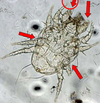Fleas, ticks, mites and Lice recognition Flashcards
What is this? and what problems does it cause? and what is most common one?

Flea (siphonaptera) - small, dark brown, wingless insect, laterlly compressed with long hind limbs and dark combs on head for ID
blood sucking
FAD
intermediate host for diphylidium
vector for bubonic plague, parvo and myxomatosis
Ctenocephalidis felis
What LC is this? What happens to the dirt?

Flea LC
Flea dirt made by adults (faeces) eaten by flea larvae
almost permenant parasite
larvae moulting is temperature dependent
LC is 3-4 weeks in summer
only 5% of population on host
What is this?

Blood sucking (narrow head, large legs) louse(phthiraptera) - piercing mouthparts, feed on blood and tissue fluid, mammals only
can cause pediculosis - anaemia, self injury, hair loss
intermediate for diphylidium
dorsoventrally flattenned
3 pairs of legs with claws
wingless
What is this?

Chewing lice
broad head
small narrow legs
rasping mouthparts, feed on ep scales, scabs, feathers etc
mammals and birds
Who does this LC belong to?

Lice
on host
2-3 weeks
transmission by close contact
only survive off host for short periods
adult lice and nits attach themselves to hair
What is this, what sex ?

Male adult hard tick
complete scutum, festoons, ornate (can be plain). prominant mouth parts
tick worry, blood loss, disease transmission, production loss, secondary inf at bite site
what is this and what sex?

Female hard tick
incomplete scutum
rest of body wall is convoluted to allow large blood meal
What is this?

Soft tick
no scutum, mouthparts not visible from dorsal surface, dont swell much as feed little and often
What do these mouthparts belong to and what do the arrows point to?

Tick mouthparts
Green = hypostome (tube for sucking host blood, has backward pointing teeth)
Red = palps (sensory organs)
Chelicerae puncture skin
mouthparts are cemented into skin and tick stands upright whilst feeding
feeds continuously and injects saliva
Who does this LC belong to?

Ticks :)
larva have 3 pairs of legs and nymph have 4
hard tick LC can be classified into 1/2/3 host
soft ticks feed little and often on many hosts
What sp is this?

Ixodes Ricinus
hard, 3 host tick
vector for: lyme disease, bovine babesiosis, louping ill, tickborne fever, tick pyaemia,
spend most of time on ground in vegetation
activity in spring and autumn
What species is this?

Amblyomma - hard, 3 host
overseas
vector for Q fever, rocky mountain spotted fever
What species is this?

Boophilus hard tick, 1 host
warmer climates
vector for babesia in cattle
What species is this?

Dermacentor tick - hard, 3 host
vector for: tickborne encephalitis, equine babesiosis
What species is this?

Rhipicephalus tick - hard, 2/3host
babesia vector
paralysis in livestock
warmer climates














